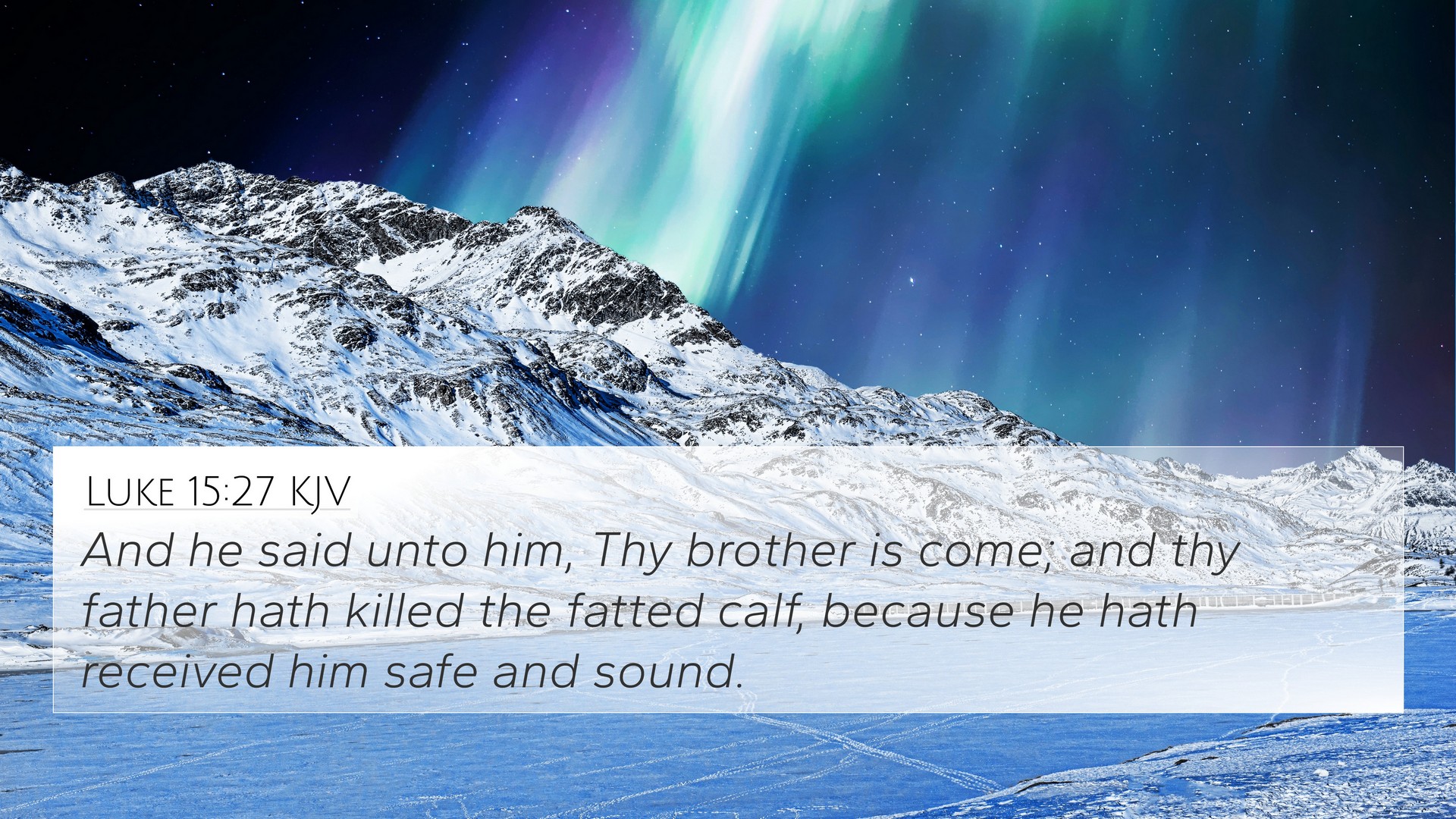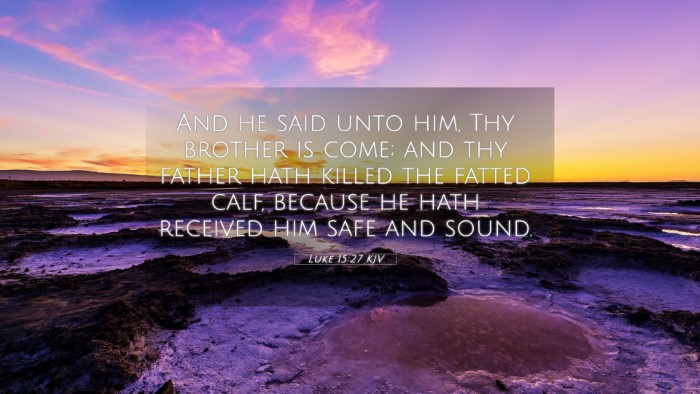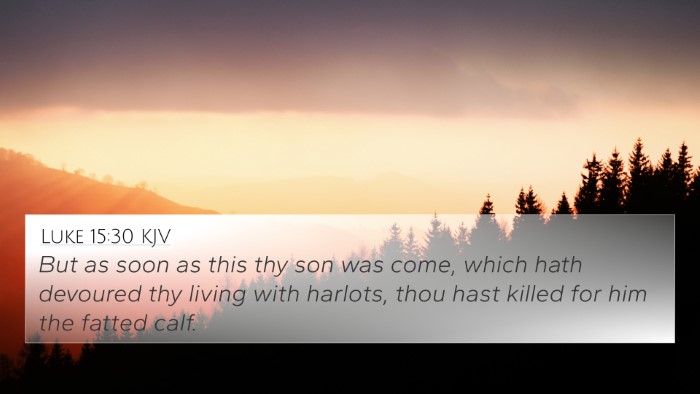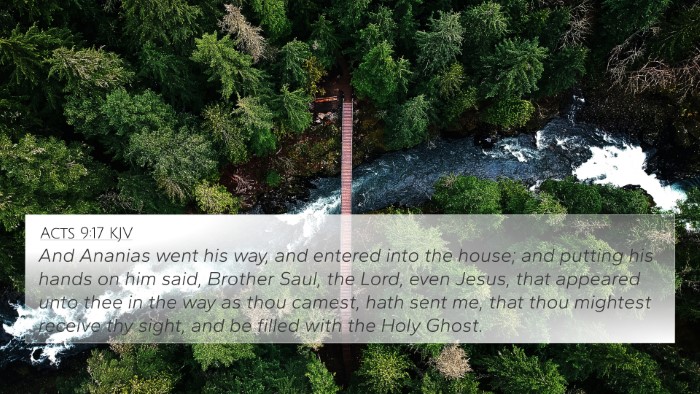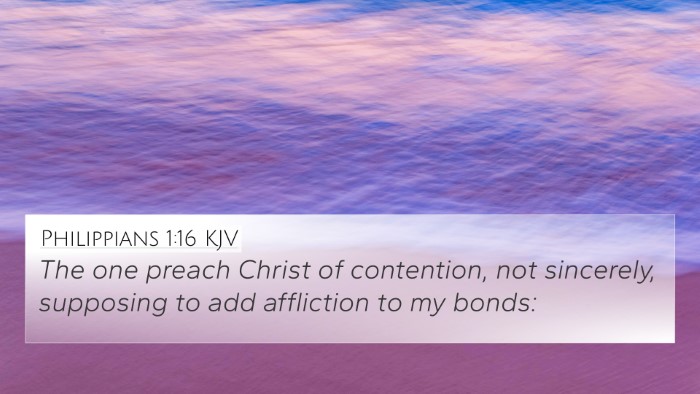Bible Verse Meaning: Luke 15:27
In Luke 15:27, we find an essential moment in the parable of the Prodigal Son, where the servant tells the elder brother about the joyful feast celebrating the return of his younger brother. This text is rich in thematic significance and reflects several biblical concepts, including forgiveness, grace, and the joy of restoration.
Summary of Biblical Meaning
This verse highlights the reaction of the household to the return of the lost son. The servant's communication serves as a bridge to show the elder brother the restoration happening within the family. The announcement of the fatted calf being slain illustrates the extravagant grace and joy that accompanies repentance and reconciliation.
Insights from Commentaries
- Matthew Henry: Henry notes that the servant’s message signifies the joy in heaven over one sinner who repents. It reflects not only the family’s happiness but signifies a deeper spiritual truth regarding redemption and God's desire to welcome back those who have strayed.
- Albert Barnes: Barnes emphasizes the significance of the elder brother's reaction. He points out that this response symbolizes the attitudes of those who are self-righteous and do not understand the grace extended to sinners, contrasting the perspectives of the humble and the proud.
- Adam Clarke: Clarke elaborates on the joyous nature of the celebration, underscoring the profound implications of forgiveness, and how the fatted calf symbolizes the cost of grace. The celebration is not solely a familial matter but a representation of God’s rejoicing over reclaimed souls.
Cross-References to Luke 15:27
Luke 15:27 can be linked to several other scripture passages that encompass themes of forgiveness and reconciliation. Below are some relevant cross-references:
- Luke 15:10: "In the same way, I tell you, there is rejoicing in the presence of the angels of God over one sinner who repents." - This verse parallels the joy in remembrance of redemption.
- Matthew 9:13: "But go and learn what this means: ‘I desire mercy, not sacrifice.’ For I have not come to call the righteous, but sinners." - This connects with the grace theme.
- Luke 15:24: "For this son of mine was dead and is alive again; he was lost and is found." - A direct illustration of the celebration's significance.
- John 3:17: "For God did not send his Son into the world to condemn the world, but to save the world through him." - This highlights Christ’s mission of restoration, akin to the narrative in Luke 15.
- Romans 5:8: "But God demonstrates his own love for us in this: While we were still sinners, Christ died for us." - Reflecting on the generous nature of God's grace.
- 2 Corinthians 5:17-18: "Therefore, if anyone is in Christ, the new creation has come: The old has gone, the new is here! All this is from God, who reconciled us to himself through Christ." - Emphasizes the restoration theme visible in the prodigal son's return.
- Ephesians 2:8-9: "For it is by grace you have been saved, through faith—and this is not from yourselves, it is the gift of God." - Highlights the grace aspect connected with the celebration in Luke 15:27.
Thematic Connections
Analyzing Luke 15:27 through the lens of the overall narrative of Scripture helps to uncover deeper meanings. Here are key themes present:
- Theme of Grace: The celebration is a clear picture of grace bestowed upon the younger son upon his return, illustrating God’s grace to humanity.
- Theme of Forgiveness: The father forgives without hesitation, which reflects God's unending mercy towards sinners.
- Theme of Celebration: The act of celebration in this parable signifies the joy in heaven over one repentance, emphasizing the importance of community in rejoicing over restored relationships.
Practical Applications
When studying Luke 15:27, believers can derive several practical applications:
- Understanding Forgiveness: This verse encourages us to be forgiving towards others, reminiscent of the father’s treatment of the prodigal.
- Embracing Grace: It invites believers to reflect on the grace they have received and to extend that grace to others.
- Community and Joy: The celebration in the story serves as a reminder of the joy that comes in community during times of restoration.
Conclusion
Luke 15:27 encapsulates profound theological truths about redemption, grace, and community. By studying this verse in conjunction with cross-references and biblical themes, a deeper understanding of God’s heart towards the lost can be garnered.
In summary, using tools like a Bible concordance or Bible cross-reference guide, one can uncover the extensive relationships between various Biblical texts. This not only enriches personal study but also enhances sermon preparation and teaching through the cross-referencing Bible study method, allowing for a thorough and insightful exploration of Scripture.
